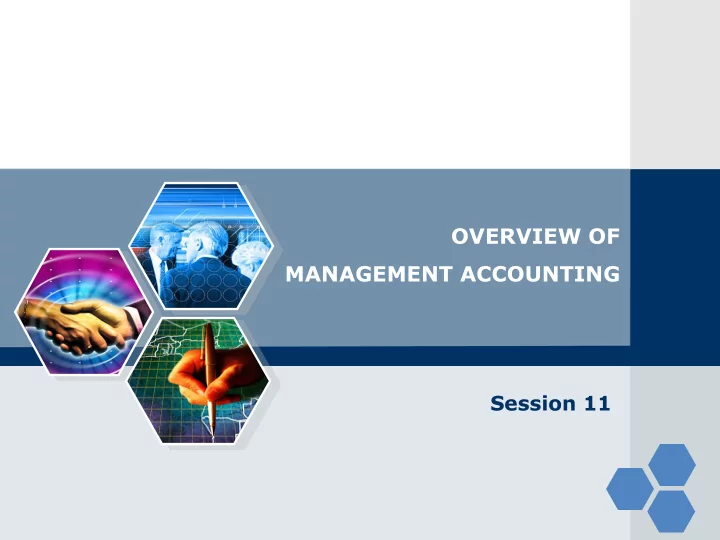

OVERVIEW OF MANAGEMENT ACCOUNTING Session 11
Session Outline Financial vs. Management Accounting Cost Accounting Cost Classification High-Low Method
Financial Accounting vs. Management Accounting Financial Accounting – Preparation of financial statements and presenting historical transactions and events of a certain Accounting entity, to the external parties to enable them to make economic decisions. Management Accounting - Provision of financial and non-financial information to all levels of management to enable them to act on their responsibility for planning, controlling and decision making.
Financial Accounting vs. Management Accounting
Cost Accounting Cost accounting is the process of determining and accumulating the cost of a product It is a process of accounting for the incurrence and the control of cost. Objectives of Cost Accounting To determine the selling price To control cost To provide information for decision making To facilitate the preparation of financial and other statements
Cost Classification This involves arranging costs into groupings of similar items. Cost classification is important for inventory valuations, measuring profits, planning, decision making and controlling. Costs can be classified based on their; Nature – Material/ Labour/ Expense Purpose - Direct/ Indirect (Overheads) Behaviour - Fixed/ Variable/ Semi Variable Function - Manufacturing/ Administration/ Selling Distribution/ Finance etc.
Cost Classification: Based on the Nature Material Cost Costs related to the materials used in manufacturing (ex: Cost of thread, cost of buttons used to manufacture a T-shirt) Labour Cost All costs relating to the employees of the organisation. (ex: salaries and wages paid to sewing staff/ supervisors/ accountants etc.) Expense Cost All costs other than material and labour cost (ex: rent/ electricity/ telephone/ insurance etc.)
Cost Classification: Based on the Purpose Direct Cost Costs which can be directly identified per unit. • Direct Material : Cost incurred on materials which can be directly identified per unit manufactured (ex: cost of cocoa in manufacturing chocolates) • Direct Labour: Labour cost which can be calculated per unit directly (ex: amount paid to a carpenter per chair, in manufacturing chairs) • Direct Expenses: Cost which can be calculated per unit directly except material and labour cost (ex: royalty fee paid per unit manufactured)
Cost Classification: Based on the Purpose Indirect Costs (Overheads) Costs which cannot be directly calculated per unit manufactured. • Indirect Material: Cost incurred on materials which cannot be directly calculated per unit (ex: Cost of machine oil used in manufacturing chocolates) • Indirect Labour: Labour costs which cannot be directly calculated per unit manufactured ex: Salaries paid to the accountants/ drivers in manufacturing a chair) • Indirect Expenses: Costs other than material and labour which cannot be directly calculated per unit manufactured (ex: Rent/ electricity/ telephone/ Insurance paid in manufacturing chocolates)
Cost Classification: Based on the Behavior
Cost Classification: Based on the Behavior Fixed Cost A cost that will not vary with the level of activity (output) within a given period of time - ex: rent Fixed cost cannot be avoided and cannot be directly controlled by the management Fixed cost per unit will decrease when output increases.
Cost Classification: Based on the Behavior Variable Cost A cost that will vary in direct proportion with the level of activity (output) within a given period of time. Variable cost can be avoided and can be directly controlled by the management. Variable cost per unit will remain constant.
Cost Classification: Based on the Behavior Semi Variable Cost A cost which contains both a fixed and a variable component (ex: telephone cost)
High-Low Method A method to separate a semi variable cost into its variable and fixed components. The cost that changes with the output will be the variable cost, where the difference between the total cost and the variable cost will be the fixed cost. Example: A company produces 10,000 units at a total cost of Rs. 80,000. When the company produces 20,000 units, the total cost amounts to Rs. 120,000. Calculate the variable cost per unit and the total fixed cost.
High-Low Method Question: When a company produces 12,000 units, the total cost is Rs. 60,000. When the output is 15,000 units, the total cost is Rs. 69,000. Calculate the variable cost per unit and the total fixed cost.
Cost Classification: Based on the Function Manufacturing Cost (Production) All costs related to manufacturing of goods and services (ex: cost of material and labour related to manufacturing) Administration Cost All costs related to controlling of the organization (ex: Administration staff salaries/ telephone cost/ Insurance) Selling Cost All costs related to sale of goods or services (ex: Sales staff salaries/ Advertising/ Sales commissions) Distribution Cost All costs related to transferring goods or services from one location to another (ex: Transportation cost/ Ware house cost) Finance Cost Costs related to borrowing money (ex: Loan interest payments)
Class Activity Classify the “Cost of Fabric” used in an Apparel company based on different cost classification methods.
Question Categorise the following costs based on the four cost classifications. Interest on bank overdraft Repairs to factory roof Tax for vans used for delivering goods Chief accountant’s salary Lubricants for factory machinery Cost of disks for firm’s computer Wages of painters engaged in production Postal charges for letters
Thank You Email – anjalee@bms.edu.lk
Recommend
More recommend